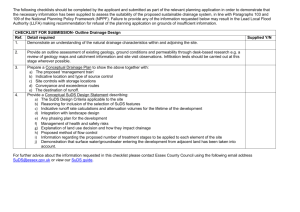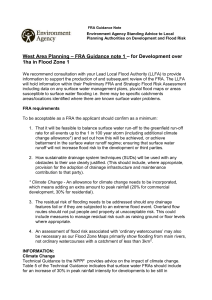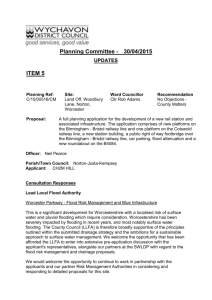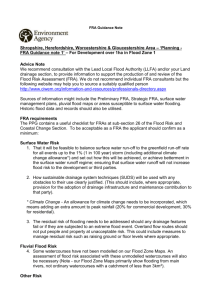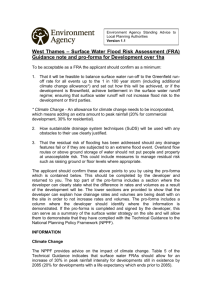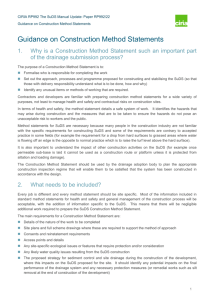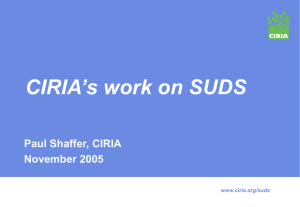For operational developments falling within Flood Zone1, the main
advertisement
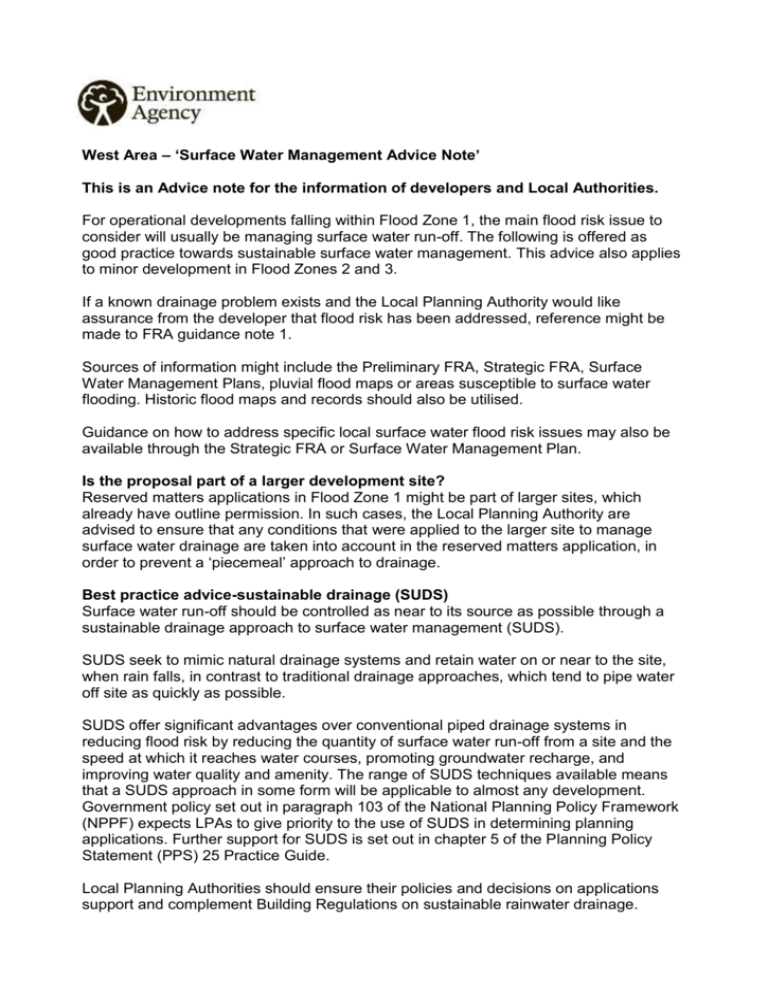
West Area – ‘Surface Water Management Advice Note’ This is an Advice note for the information of developers and Local Authorities. For operational developments falling within Flood Zone 1, the main flood risk issue to consider will usually be managing surface water run-off. The following is offered as good practice towards sustainable surface water management. This advice also applies to minor development in Flood Zones 2 and 3. If a known drainage problem exists and the Local Planning Authority would like assurance from the developer that flood risk has been addressed, reference might be made to FRA guidance note 1. Sources of information might include the Preliminary FRA, Strategic FRA, Surface Water Management Plans, pluvial flood maps or areas susceptible to surface water flooding. Historic flood maps and records should also be utilised. Guidance on how to address specific local surface water flood risk issues may also be available through the Strategic FRA or Surface Water Management Plan. Is the proposal part of a larger development site? Reserved matters applications in Flood Zone 1 might be part of larger sites, which already have outline permission. In such cases, the Local Planning Authority are advised to ensure that any conditions that were applied to the larger site to manage surface water drainage are taken into account in the reserved matters application, in order to prevent a ‘piecemeal’ approach to drainage. Best practice advice-sustainable drainage (SUDS) Surface water run-off should be controlled as near to its source as possible through a sustainable drainage approach to surface water management (SUDS). SUDS seek to mimic natural drainage systems and retain water on or near to the site, when rain falls, in contrast to traditional drainage approaches, which tend to pipe water off site as quickly as possible. SUDS offer significant advantages over conventional piped drainage systems in reducing flood risk by reducing the quantity of surface water run-off from a site and the speed at which it reaches water courses, promoting groundwater recharge, and improving water quality and amenity. The range of SUDS techniques available means that a SUDS approach in some form will be applicable to almost any development. Government policy set out in paragraph 103 of the National Planning Policy Framework (NPPF) expects LPAs to give priority to the use of SUDS in determining planning applications. Further support for SUDS is set out in chapter 5 of the Planning Policy Statement (PPS) 25 Practice Guide. Local Planning Authorities should ensure their policies and decisions on applications support and complement Building Regulations on sustainable rainwater drainage. Approved Document Part H of the Building Regulations 2000 establishes a hierarchy for surface water disposal, which encourages a SUDS approach beginning with infiltration where possible e.g. soakaways or infiltration trenches. Where SUDS are used, it must be established that these options are feasible, can be adopted and properly maintained and would not lead to any other environmental problems. For example, using soakaways or other infiltration methods on contaminated land carries groundwater pollution risks and may not work in areas with a high water table. Where the intention is to dispose to soakaway, these should be shown to work through an appropriate assessment carried out under BRE Digest 365. Provision for long-term maintenance should be provided as part of any SUDS scheme submitted to the LPA. Model legal agreements that provide a mechanism for SUDS maintenance can be accessed on the CIRIA web site at: http://www.ciria.com/suds/model_agreements.htm . Further information and references on SUDS can be found in chapter 5 of the PPS25 Practice Guide. The Interim Code of Practice for Sustainable Drainage Systems provides advice on design, adoption and maintenance issues and a full overview of other technical guidance on SUDS. The Interim Code of Practice is available electronically on CIRIA's web site at: http://www.ciria.com/suds/interim_code.htm . Disposal to public sewer Where it is intended that disposal is made to public sewer, the Water Company or its agents should confirm that there is adequate spare capacity in the existing system taking future development requirements into account. Designing for exceedence For on/near site flooding, the PPS25 Practice Guide at paragraph 5.51 states that: “For events with a return-period in excess of 30 years, surface flooding of open spaces such as landscaped areas or car parks is acceptable for short periods, but the layout and landscaping of the site should aim to route water away from any vulnerable property, and avoid creating hazards to access and egress routes (further guidance in CIRIA publication C635 Designing for exceedence in urban drainage - good practice). No flooding of property should occur as a result of a one in 100 year storm event (including an appropriate allowance for climate change). In principle, a well-designed surface water drainage system should ensure that there is little or no residual risk of property flooding occurring during events well in excess of the return-period for which the sewer system itself is designed. This is called designing for event exceedence.” The CIRIA publication `Designing for exceedence in urban drainage-good practice' can be accessed via the following link: http://www.ciria.com/suds/ciria_publications.htm For off-site flooding, the PPS25 Practice Guide states at paragraph 5.54: “For the range of annual flow rate probabilities up to and including the one per cent annual exceedence probability (1 in 100 years) event, including an appropriate allowance for climate change, the developed rate of run-off into a watercourse, or other receiving water body, should be no greater than the existing rate of run-off for the same event. Run-off from previously-developed sites should be compared with existing rates, not greenfield rates for the site before it was developed. Developers are, however, strongly encouraged to reduce runoff rates from previously-developed sites as much as is reasonably practicable. Volumes of run-off should also be reduced wherever possible using infiltration and attenuation techniques. Interim guidance on calculation of site runoff rates can be found on the CIRIA website: http://www.ciria.org Climate Change The Technical Guidance to the NPPF provides advice on the impact of climate change. Table 5 of the Technical Guidance indicates that surface water FRAs should include for an increase of 30% in peak rainfall intensity for developments to be still in existence by 2085 (20% for developments with a life expectancy which ends prior to 2085). Other flood risk issues to consider for development in Flood Zone 1 - Dry Islands There are some areas within Flood Zone 1 that are surrounded by areas at a higher risk of flooding i.e. areas falling within Flood Zones 3 and 2. In certain cases development upon such 'dry islands' can present particular hazards to public safety and risks such as those associated with maintaining safe access and exit for occupants during flood events. The distribution of dry islands and risks posed by them in terms of access/exit vary considerably across the country. (If there is a concern on this issue please contact the local Environment Agency Sustainable Places Team). Note: Development which involves a culvert or an obstruction to flow on an Ordinary Watercourse will require consent under the Land Drainage Act 1991 and the Flood and Water Management Act 2010. In the case of an Ordinary Watercourse the responsibility for Consenting lies with the Lead Local Flood Authority (LLFA). In an internal drainage district, the consent of the Internal Drainage Board, instead of the LLFA, is required for the above works under Section 23 of the Land Drainage Act 1991. An Ordinary Watercourse is defined as any watercourse not identified as a Main River on maps held by the Environment Agency and DEFRA. For further information on Ordinary Watercourses contact the LLFA. As of November 2012 (Flood Map update) in Midlands West area, the Flood Zone 2 outline includes historical flooding data.
